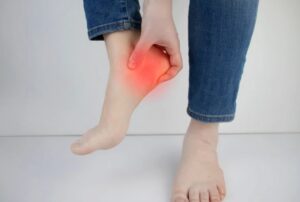Recently, many parents have been asking: “After sports, my child complains about heel pain. It’s fine when they rest, but running or walking makes it worse. What should I do? Should I use ice or heat?” If you’ve had the same question, this article will help you make the right choice.
Common Cause: Sever’s Disease
One of the most common reasons for heel pain in kids is Sever’s disease, also known as calcaneal apophysitis. It mostly affects active children between the ages of 8 and 14, especially those who love running, jumping, or playing sports.
This condition happens when the growth plate in the heel (which is still developing) gets irritated from repeated stress, causing pain and inflammation.
Signs to Watch For:
- Pain at the back of the heel, especially when pressed
- Pain gets worse during or after sports
- Limping or walking on tiptoes to avoid pressure on the heel
Ice or Heat: Which One Should You Use?
If the pain is new or happens right after sports:
Use ICE.
- Why ice helps: It reduces swelling and numbs the pain
- How to do it: Wrap an ice pack in a towel and apply it to the heel for 15–20 minutes, 2–3 times a day. Never put ice directly on the skin.
If the pain has been there for a few days and there’s no swelling:
Use HEAT.
- Why heat helps: It relaxes tight muscles and improves blood flow
- How to do it: Use a warm towel or heat pack on the heel for up to 15 minutes. Always check the temperature to avoid burns.
🚫 Important: Don’t switch between ice and heat too quickly. And if the pain is severe or doesn’t improve, talk to your child’s doctor.
Other Home Care Tips
- Limit high-impact sports until the pain improves
- Wear good shoes with proper cushioning and heel support. You can also try soft heel inserts.
- Do gentle stretching for the heel and calf muscles (ask your doctor or physical therapist for safe exercises)
- Keep a healthy weight to reduce stress on growing feet
- Use over-the-counter pain relief like ibuprofen if needed — but only under medical guidance
When to See a Doctor
Seek medical help if:
- Pain lasts more than 2 weeks
- Pain doesn’t go away with rest
- The heel is red, swollen, or warm
- Your child refuses to walk or limps badly
Final Thoughts
Heel pain is common in growing kids, especially during active periods. Most cases of Sever’s disease can be managed at home with the right care. Ice and heat are simple tools — but knowing when and how to use them can make a big difference in your child’s recovery. And remember, if you’re ever unsure, don’t hesitate to ask your doctor.













